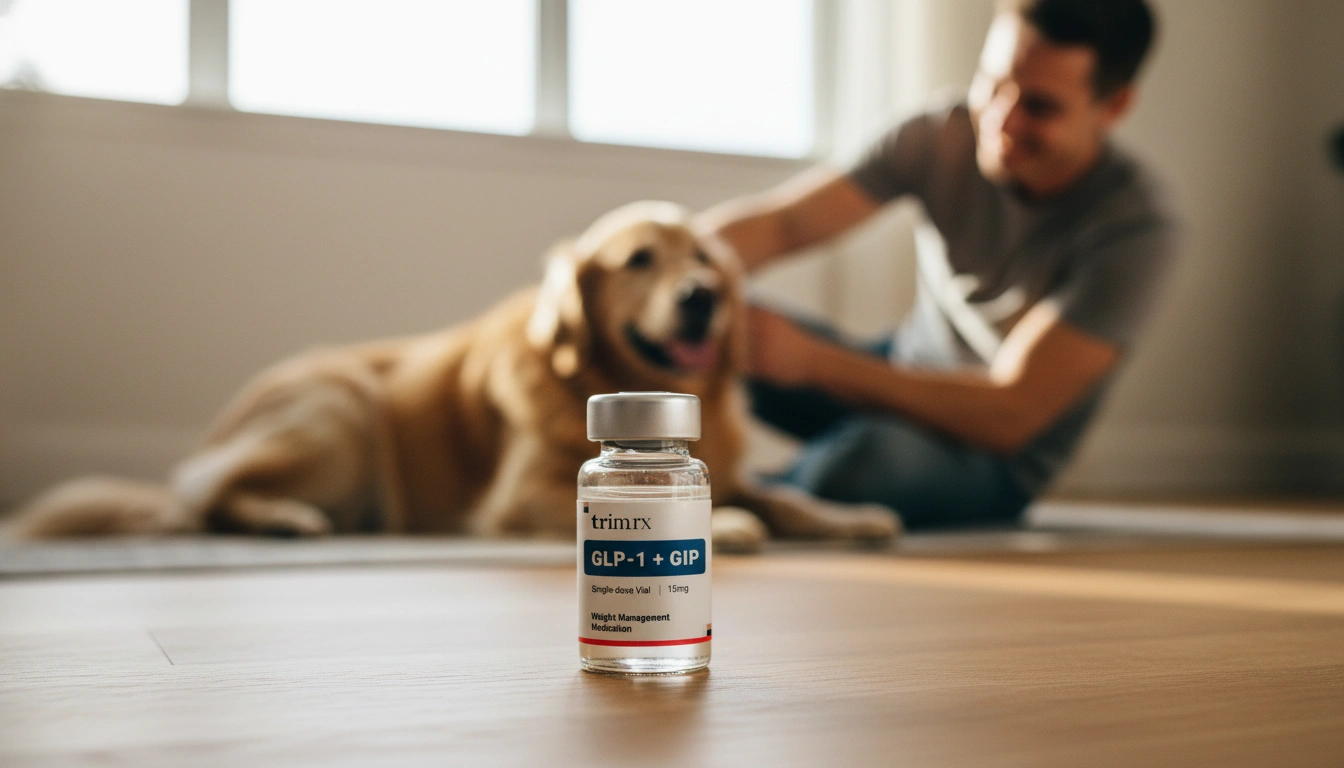What Do GLP-1 Injections Do? Exploring Their Role in Weight Loss and Diabetes Management

Introduction
Did you know that nearly 42% of adults in the United States are classified as obese? This alarming statistic underscores the urgent need for effective weight management solutions. As we navigate the complexities of obesity and related health issues, innovative treatments are emerging, one of which includes glucagon-like peptide-1 (GLP-1) injections. These medications have gained significant attention for their dual role in managing Type 2 diabetes and promoting weight loss.
At TrimRx, we are dedicated to providing clinically proven, personalized weight loss solutions that prioritize safety and effective care. Our journey began with a vision of helping individuals embrace healthier lifestyles through advanced telehealth innovations. In this blog post, we will delve into the world of GLP-1 injections, exploring their mechanisms, benefits, and how they can fit into a comprehensive weight management strategy. By the end, you will gain a deeper understanding of what GLP-1 injections do and whether they might be a viable option for your weight loss journey.
We will explore the following key aspects:
- What GLP-1 is and how it functions in the body.
- The benefits of GLP-1 injections for weight loss and diabetes management.
- The different types of GLP-1 medications available.
- How TrimRx’s personalized programs integrate GLP-1 injections for effective weight loss.
- Common side effects and considerations when using GLP-1 medications.
Let’s start by understanding what GLP-1 is and how it operates within our bodies to influence weight and glucose levels.
Understanding GLP-1: The Hormone Behind the Injections
GLP-1 is a hormone that our intestines produce in response to food intake. It plays several crucial roles in the body, particularly in regulating blood sugar levels and appetite. When we consume food, GLP-1 is released and serves the following functions:
- Stimulates Insulin Secretion: GLP-1 prompts the pancreas to release insulin, a hormone that helps lower blood sugar by facilitating glucose uptake into cells.
- Suppresses Glucagon Secretion: It inhibits the release of glucagon, a hormone that raises blood sugar levels, thus helping to maintain balanced glucose levels.
- Slows Gastric Emptying: GLP-1 delays the emptying of the stomach, which prolongs the feeling of fullness after eating and helps control appetite.
These physiological effects make GLP-1 a key player in managing Type 2 diabetes and promoting weight loss. By mimicking the action of GLP-1, GLP-1 receptor agonists (injections) can effectively support individuals struggling with these conditions.
The Benefits of GLP-1 Injections
GLP-1 injections offer a range of benefits that extend beyond blood sugar management. Here are some of the most notable advantages:
1. Weight Loss Support
One of the most appealing aspects of GLP-1 injections is their ability to promote weight loss. Research indicates that individuals using GLP-1 agonists experience significant weight reductions. By enhancing feelings of satiety and reducing overall caloric intake, these medications can help individuals achieve and maintain a healthier weight.
2. Improved Blood Sugar Control
For those with Type 2 diabetes, GLP-1 injections can lead to better glycemic control. By stimulating insulin secretion and suppressing glucagon, these medications help to manage blood sugar levels effectively. This dual action can lead to improvements in overall metabolic health.
3. Cardiovascular Benefits
Studies suggest that GLP-1 receptor agonists may also provide cardiovascular benefits. These medications have been linked to reduced risks of heart disease, stroke, and other cardiovascular events. This is particularly important for individuals with Type 2 diabetes, who are at a higher risk for cardiovascular complications.
4. Potential for Long-Term Weight Management
Unlike many weight loss solutions that only provide short-term results, GLP-1 injections may offer a sustainable approach to weight management. By addressing the underlying hormonal imbalances that contribute to obesity and diabetes, these medications can support long-lasting change.
5. Convenience and Flexibility
GLP-1 injections can be administered either daily or weekly, depending on the specific medication prescribed. This flexibility allows individuals to incorporate them into their daily routines with relative ease.
Types of GLP-1 Medications
Several GLP-1 receptor agonists are currently available, each with distinct characteristics and dosing regimens. Here are some of the most commonly prescribed options:
1. Semaglutide
Available in both injectable and oral forms, Semaglutide has been shown to be highly effective for both weight loss and blood sugar control. Brand names include Ozempic® (for diabetes management) and Wegovy® (for obesity treatment).
2. Liraglutide
Liraglutide is another well-known GLP-1 agonist, marketed under the names Victoza® for diabetes and Saxenda® for weight management. It is typically administered once daily.
3. Dulaglutide
Sold under the brand name Trulicity, Dulaglutide is administered once a week and is effective for managing blood sugar levels in Type 2 diabetes.
4. Tirzepatide
A newer entrant, Tirzepatide (Mounjaro®) is a dual GLP-1/GIP receptor agonist that has shown promising results in clinical trials for both diabetes management and weight loss.
At TrimRx, we offer personalized treatment plans that may include these GLP-1 medications. By taking our free assessment quiz, we can help you determine your eligibility for prescription weight loss medications tailored to your unique needs.
Integrating GLP-1 Injections into a Personalized Weight Loss Program
At TrimRx, we believe that sustainable weight loss requires a comprehensive approach combining medical science, technology, and individual support. Here’s how GLP-1 injections fit into our personalized weight loss programs:
1. Comprehensive Assessment
Before initiating any treatment, we encourage individuals to complete our free assessment quiz. This helps us understand your unique health profile and allows us to create a customized treatment plan that may include GLP-1 injections.
2. Medically Supervised Care
Our programs are designed to provide medically supervised care, ensuring that you receive ongoing support and monitoring throughout your weight loss journey. Our healthcare professionals are here to answer your questions and adjust your treatment as needed.
3. Personalized Support
We offer unlimited support through our platform, connecting you with healthcare professionals who are invested in your success. Whether you have questions about your medications or need guidance on lifestyle changes, we’re here to help.
4. Lab Work and Monitoring
Regular lab work and health assessments are integral to our approach. Monitoring your progress allows us to make informed adjustments to your treatment plan, ensuring that you achieve your weight loss goals safely and effectively.
5. No Hidden Fees
At TrimRx, we pride ourselves on transparency. Our services include consultations, medications, lab work, and support without hidden fees, making it easier for you to focus on your health journey.
If you’re ready to explore how GLP-1 injections can support your weight loss goals, take our free assessment quiz today!
Common Side Effects and Considerations
While GLP-1 injections offer numerous benefits, it’s essential to be aware of potential side effects. Most individuals tolerate these medications well, but some may experience:
- Gastrointestinal Issues: Nausea, vomiting, diarrhea, and constipation are the most common side effects, often occurring during the initial stages of treatment. These symptoms may subside over time as the body adjusts to the medication.
- Injection Site Reactions: Some individuals may experience redness or irritation at the injection site.
- Risk of Hypoglycemia: While GLP-1 injections have a lower risk of causing low blood sugar compared to other diabetes medications, it can still occur, especially when combined with insulin or sulfonylureas.
- Pancreatitis: There have been reports of pancreatitis in individuals using GLP-1 medications, although this is rare. Patients should be aware of the symptoms and contact their healthcare provider if they experience severe abdominal pain.
Before starting any new medication, it’s crucial to discuss your medical history and any potential risks with your healthcare provider. At TrimRx, our team is here to provide the guidance and support you need to make informed decisions about your health.
Conclusion
GLP-1 injections represent a promising advancement in the management of Type 2 diabetes and obesity. By mimicking the natural GLP-1 hormone, these medications can help regulate blood sugar levels, promote weight loss, and potentially offer cardiovascular benefits. At TrimRx, we are committed to helping you navigate your weight loss journey through personalized care, effective medications, and continuous support.
As you consider your options, we invite you to take our free assessment quiz to explore whether GLP-1 injections might be suitable for you. Together, we can work towards achieving your health goals and embracing a healthier lifestyle.
FAQ
What are GLP-1 injections used for?
GLP-1 injections are primarily used to manage Type 2 diabetes and promote weight loss.
How do GLP-1 injections work?
They mimic the action of the GLP-1 hormone, stimulating insulin secretion, suppressing glucagon, and slowing gastric emptying, which helps regulate blood sugar levels and reduces appetite.
Are there any side effects associated with GLP-1 injections?
Common side effects include nausea, vomiting, diarrhea, and injection site reactions. It’s important to discuss any concerns with your healthcare provider.
Can anyone use GLP-1 injections for weight loss?
Eligibility for GLP-1 injections varies based on individual health profiles. Completing our free assessment quiz can help determine if they are suitable for you.
How can TrimRx help me with weight loss?
At TrimRx, we provide personalized weight loss programs that include medically supervised care, comprehensive assessments, lab work, and support, helping you achieve sustainable results.

Transforming Lives, One Step at a Time
Keep reading
Vitamin B12 and GLP-1 Medications: What to Know
GLP-1 medications can lower B12 absorption and intake; learn symptoms, food sources, supplement options, and how to monitor levels.
Semaglutide Injection Site Reactions: What To Know
Learn why semaglutide injections can cause redness, swelling or nodules, how to prevent and treat them, and when to seek medical care.
TrimRx vs Friday’s
Compare TrimRx and Friday’s telehealth GLP-1 weight-loss programs: pricing, medical support, coaching, delivery, and which fits your needs.



